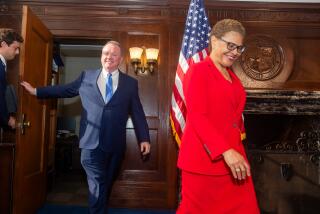McDonnell Taps New Leader for Jetliner Group
- Share via
McDonnell Douglas Corp., looking to inject fresh energy into its languishing Douglas Aircraft Co. commercial jetliner group, named Michael M. Sears on Monday to head the huge Long Beach-based operation.
Sears, 48, is a 27-year McDonnell veteran who most recently was general manager of the company’s largest tactical-aircraft program, the F/A-18 Hornet jet fighter that’s flown by the Navy and Marine Corps. He holds bachelor’s and master’s degrees in electrical engineering from Purdue University and has a master’s in engineering management from the University of Missouri.
At Douglas Aircraft, Sears succeeds Robert H. Hood Jr., 63, who will remain president emeritus of the division until he retires later this year. Sears will be succeeded on the F/A-18 program by his deputy, Gerald E. Daniels, 50.
Sears, who will oversee a work force of about 10,000 in Long Beach, faces a formidable task. Douglas remains a distant third in market share behind Boeing Co. and Airbus Industrie of Europe in the worldwide commercial jetliner industry, an industry that is only now beginning to rebound from a severe recession in the early 1990s.
Douglas also is barely profitable, and there has long been speculation that its poor-selling MD-11 wide-body jetliner will be shelved, or that McDonnell might sell the division entirely.
Douglas also builds the MD-90 and MD-80 single-aisle twin jets, and last year it launched development of a new 110-seat jet, the MD-95, after getting an initial order from ValuJet Airlines.
Last year, Douglas delivered 50 airplanes, compared with 169 in 1991, when the company was completing the production of airplanes that had been ordered in the late-1980s before the industry’s fortunes deteriorated.
Harry Stonecipher, McDonnell’s president and chief executive, said Sears’ mandate now is to “define the product line and sell some airplanes, it’s really that simple.” In a telephone interview, Stonecipher said Sears’ experience in selling the F/A-18 to foreign nations also will help him market Douglas’ jets to the world’s airlines.
In a separate interview, Sears said another of his challenges is convincing the world’s airlines that Douglas is a long-term player in the commercial industry, and that it will have aircraft to suit their needs.
“It’s an issue we’re going to have to deal with,” he said. “When we talk to customers, we need to be credible with our designs, and credible about our business future.”
Indeed, Stonecipher said the MD-11 not only “is here to stay” but that Douglas is working on a redesign of the three-engine jet to make it more competitive with Boeing and Airbus wide-bodies.
“All we need to do is stretch it and increase its range, and we’re working on that,” he said.
In recent meetings with several domestic and overseas carriers, “it was obvious to me that we did not have the right answer” with the existing MD-11, he said. “Now we’re doing those things to match their needs.”
Meanwhile, Hood steps down as Douglas’ president after leading the division through the industry’s severe recession. It was shortly after Hood became president in 1989 that industrywide commercial orders peaked and then began their nose dive.
As new orders fell, Hood and other Douglas executives slashed Douglas’ work force, cut other operating costs and streamlined production procedures in order to survive. Douglas’ work force, currently 11,000 nationwide, has plunged from 35,800 people in 1990.
The effort enabled Hood to keep Douglas at least slightly profitable. Last year, Douglas’ operating earnings fell to a paltry $39 million (excluding a one-time charge related to the MD-11’s development costs) from $47 million in 1994, even though its revenue rose to $3.9 billion from $3.2 billion.
“Douglas has done a great job just by breaking even” in the recession, said Wolfgang Demisch, aerospace analyst at BT Securities Corp. in New York. “But the challenge now is not to survive, it’s to make a bigger profit” as the industry improves, “and that’s Sears’ job.”
Sears, a native of St. Louis where McDonnell Douglas is based, gets high marks for reducing production costs of the F/A-18 while simultaneously developing new versions of the fighter, thereby making the jet “much more competitive” against other U.S.-made fighters being marketed to other countries, Demisch said.
Douglas Griffith, the head of the union that represents many of Douglas’ hourly workers in Long Beach, said he hopes Sears will provide “more hands-on leadership” at the company.
Griffith, president of United Aerospace Workers Local 148 in Lakewood, said he met Sears on Monday and was encouraged that Sears told him “the first thing he’s going to do is spend a great deal of time out on the [assembly] floor . . . talking to people.”
More to Read
Inside the business of entertainment
The Wide Shot brings you news, analysis and insights on everything from streaming wars to production — and what it all means for the future.
You may occasionally receive promotional content from the Los Angeles Times.











